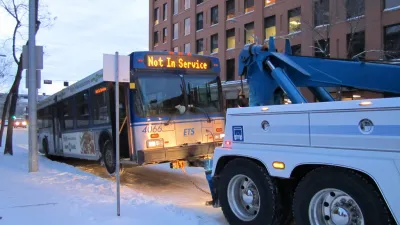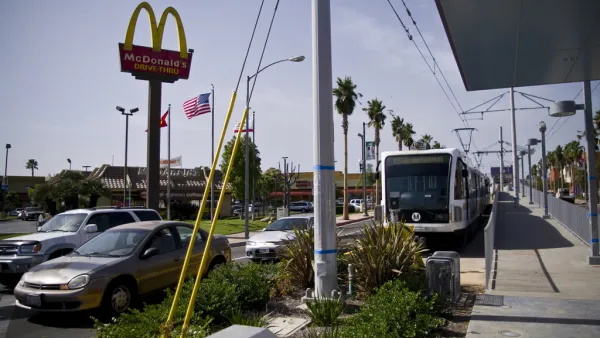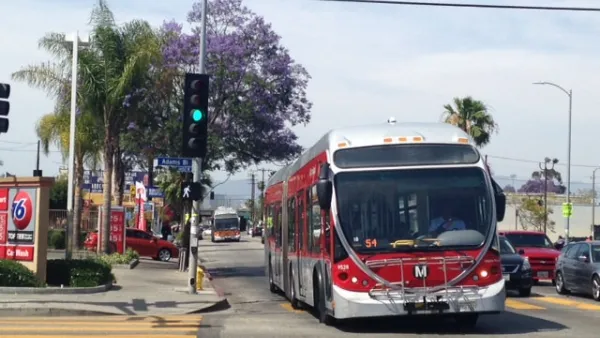Over the past two years or so, transit ridership has begun to decline. It seems that this decline has been most widespread among cities with relatively weak transit systems.

Between 1995 and 2015, American transit ridership rose from 7.8 billion trips to 10.6 billion. But over the past couple of years, transit ridership in most cities has began to dip. Between the third quarter of 2016 and the third quarter of 2017, U.S.ridership declined by 3 percent. (Ridership also declined slightly in 2015.)
Why has ridership been declining? I’d like to focus on two possible explanations. One explanation focuses on the rise of alternatives to both private automobiles and public transit, such as Uber and bicycling.
If this explanation were a major factor, we would expect to see ridership declines in the cities where taxicabs and bicycling were most common. Although I have found no data on taxi use by city, I would guess that these cities would be the most compact, walkable, transit-oriented cities. There are four major cities where fewer than half of urban commuters use a car to get to work: Boston, New York, San Francisco and Washington. In all four cities, transit ridership decreased by 3-5 percent over the last year, roughly the same as the national average. In 2015-16, transit ridership actually increased in three of the four cities (all but Washington).
Adding Philadelphia, Seattle, and Chicago (where 60-67 percent of commuters drive) doesn’t change this result very much: Chicago’s 2016-17 decline was close to the national average, Philadelphia declined a bit more (by just over 5 percent), and Seattle ridership rose. Similarly, in 2015-16 transit ridership rose in Seattle, while declining modestly (1-3 percent) in Philadelphia and Chicago. In sum, ridership in the least auto-oriented cities is roughly in line with national trends; it seems to me that if taxis and bicycling were the major cause of ridership decline, those cities would be experiencing larger ridership declines than other cities.
A second explanation focuses on economic growth; as the economy has improved and gas prices have flattened out, it might be the case that more working-class riders can afford to buy cars, and that a few riders who already owned cars can afford to drive more. Thus, people who could not afford cars during the recession have become "choice riders" and that some of them have exercised the choice to drive.
It seems to me that if this view were correct, transit ridership would decline most significantly in cities where most people use cars daily—for example, cities in which over 90 percent of commuters drive to work. Major cities in this category include Columbus, El Paso, Fort Worth, Indianapolis, Jacksonville, Memphis, Nashville, and San Antonio. The data modestly supports this hypothesis: in five of the eight cities, ridership declined more than the national average (by between 4 and 7 percent) between the third quarter of 2016 and the third quarter of 2017. Ridership declined by about the same as the national average in Indianapolis, and by less than the average in Nashville(2 percent) and Columbus (0.7 percent).
What about in 2015-16 (when national ridership declined by 1.6 percent)? In six of the eight "90 percent car" cities, transit ridership declined by more than the national average, ranging from 4 percent in Nashville to 8 percent in Fort Worth. In two other cities (Columbus and Jacksonville), ridership declined but by less than 1 percent.
On balance, it seems that ridership has declined the most in cities where transit was already rather weak, and thus that the national ridership decline may be related to the growing economy. But next year's data might support a different hypothesis.

Analysis: Cybertruck Fatality Rate Far Exceeds That of Ford Pinto
The Tesla Cybertruck was recalled seven times last year.

National Parks Layoffs Will Cause Communities to Lose Billions
Thousands of essential park workers were laid off this week, just before the busy spring break season.

Retro-silient?: America’s First “Eco-burb,” The Woodlands Turns 50
A master-planned community north of Houston offers lessons on green infrastructure and resilient design, but falls short of its founder’s lofty affordability and walkability goals.

Test News Post 1
This is a summary

Analysis: Cybertruck Fatality Rate Far Exceeds That of Ford Pinto
The Tesla Cybertruck was recalled seven times last year.

Test News Headline 46
Test for the image on the front page.
Urban Design for Planners 1: Software Tools
This six-course series explores essential urban design concepts using open source software and equips planners with the tools they need to participate fully in the urban design process.
Planning for Universal Design
Learn the tools for implementing Universal Design in planning regulations.
EMC Planning Group, Inc.
Planetizen
Planetizen
Mpact (formerly Rail~Volution)
Great Falls Development Authority, Inc.
HUDs Office of Policy Development and Research
NYU Wagner Graduate School of Public Service





























